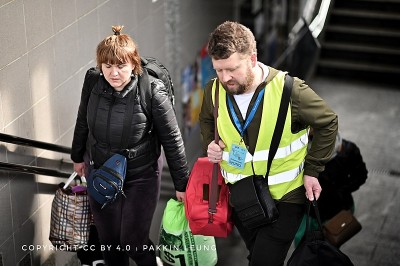Insights into the Situation of Ukrainian Women Displaced in Austria
In the summer of 2022, the Austrian Institute for Family Research at the University of Vienna, on behalf of the Austrian Integration Fund (ÖIF), surveyed displaced women from Ukraine for the first time about their living situation and future plans in Austria. The results showed that at that time 90 percent of the respondents felt very well off and had an impressive level of professional qualifications. A new study now provides new insights into the situation of Ukrainian displaced persons in Austria.
 Of the nearly 100,000 Ukrainian displaced persons in Austria, only 13% still plan to return to Ukraine. / Picture: © Wikimedia Commons; Pakkin Leung, CC BY 4.0
Of the nearly 100,000 Ukrainian displaced persons in Austria, only 13% still plan to return to Ukraine. / Picture: © Wikimedia Commons; Pakkin Leung, CC BY 4.0
Now, about 18 months after the outbreak of the war in Ukraine, current findings on the situation of Ukrainian women in Austria are available. The research report "Ukraine Displaced Persons in Austria One Year after the Start of the War. Follow-up Survey on the Situation of Ukrainian Women" offers insights into the current situation.
Work and occupation
The willingness of displaced Ukrainian women to work remains high. Already a good third (34%) of the respondents are employed in Austria. The most common occupations are cleaning (31%), hospitality (14%), education (9%), trade/distribution and sales (8% each), and health (7%). Women who are still looking for work are most interested in office work (46%), social (41%) and administrative (36%) work, hospitality (29%), and education and health (about a quarter each). Among women who are not currently employed, about 56% are actively looking for work. A quarter of women who have not been employed are not currently looking for work. The main reasons for this are the desire to further improve their German language skills (82%), to take care of their children (one-third), and to have their education recognized (one-fourth). About half (46%) plan to take these steps in the near future.
High level of education
The educational level of the women surveyed remains very high. Almost three-quarters (73%) of the respondents have a university degree, and another 10% have not yet completed their university education. A secondary school diploma is held by 13%. When vocational training and experience are combined, the most frequently cited areas are office (25%), finance (24%), education (23%), trade/distribution (21%), and sales and administration (20% each). Differences can be seen depending on the age group: In the youngest age group (18-25 years), more women have professional training in the health sector (19%), while the oldest age group (41-55 years) has more professional experience in the education sector (26%).
Language skills in German
Over 35% of the women surveyed say they already understand German well but still need to learn how to speak it. 10% say they can already speak German well. Almost 45% understand German partially, but cannot yet express themselves adequately. Evaluations of German courses supported by the ÖIF show that Ukrainian displaced persons achieve above-average results in integration exams. In 2022, 77% of Ukrainian IDPs passed the integration exam at the A2 level and 86% at the B1 level. These results are 30 to 50 percentage points higher than the largest refugee groups from Syria and Afghanistan.
Future plans in Austria
The women surveyed indicated that their life satisfaction increases with their German language skills. More than half (66%) of the women who rated their knowledge of German as "high" were very or somewhat satisfied with their lives in Austria. Among women who said they did not know German ("not at all"), only 37% were satisfied with their life in the country. Compared to the previous year, only 13% of respondents plan to return to Ukraine, with only a fraction (1%) planning to do so in the coming weeks. The specific intention to bring family members to Austria is not widespread, although the desire to bring one's parents to the country has increased noticeably compared to 2022. Displaced women are most likely to plan to bring their mother (12%), siblings (6%), and father (5%) to Austria.



